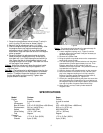
13
SICKLE MOWER
Figure 18
Figure 19
LUBRICATION
Check the Drive Assembly oil level every 8 hours of
operation by removing the Oil Level Plug, (8 in Figure
19). If oil runs out, the oil level is all right; if not, oil must
be added.
To add oil, remove the Oil Filter Plug, (2 in Figure 19), and
pour through the Oil Filler Hole until oil begins to run
out the Oil Level Hole. Replace both Plugs before
mowing.
Use SAE 140 in the Drive Assembly.
To lubricate the Universal Joint, remove the Grease Plug,
(3 in Figure 19), and fill about half-full with general
purpose grease.
ATTACHING
The Sickle Mower attaches to the convertible 7.6 tractor
using two Nuts and two Bolts. See Figure 18.
SAFETY PRECAUTIONS
Never attempt to clear the Mower, or make any
adjustment whatsoever, unless the attachment is out of
gear and stopped, and the Tractor Engine is stopped.
Never handle the attachment by any cutting surface.
Keep hands away from Knife Sections. Grasp the
Mower by its Drive Column and other non-cutting
surfaces to carry it.
Try to keep clear of rocks and debris, as these will
damage the cutting surfaces.
ADJUSTMENTS
To insure satisfactory performance, perform the following
adjustments as required:
Bolts
Although the Sickle Mower is built and balanced carefully
it is still subject to vibration. Periodically tighten all Nuts
and Bolts, doing this at more frequent intervals when
doing heavy cutting.
Clips
proper adjustment, the Clips should allow the Knife to
slide back and forth easily (with the pressure of a finger
and thumb). The Clips should hold the Knife in firm
contact with the Shear Plates, (7 in Figure 19), but
should not cause binding. To adjust, knock the Clips
down gradually with taps from a light hammer.
Swivel Action
To increase swivel action allowing the Mower to follow the
contour of the ground, loosen the Bolts, (6 in Figure
19).
When these Bolts are tightened firmly, the Mower is held
in rigid position. The Bolts should be tight enough to
the Guide Bar will hold its position until lowered, but
loose enough for the Guide Bar to follow the contour of
the ground.
Guards
Always keep the Guards, (7 in Figure 19), in alignment.
Tap with a light hammer until the knife sections lie flat
on the Shear Plates of the Guards. Keep the Guard
Bolts tightened securely.
CARE OF THE KNIFE
For best performance, keep the Knife Sections sharp. To
remove the Knife for sharpening, remove the Knife
Brackets Screws, (5 in Figure 19) and slip the Knife out
either side. Grind the Knife sections along the same
bevel as ground originally. When replacing the Knife,
make sure the Knife Bracket Screws are tightened
firmly.
NOTE: It is good practice always to have an extra Knife,
already sharpened, which you can put on the Mower
when needed.
No lubrication is required for the Knife while in operation.
However, to prevent rust, oil the Knife and Guide Bar
with a thin coat of light oil after operating. Use a paint
brush or similar type of applicator. When the Mower is
to be stored for any period of time, clean it thoroughly
and apply general purpose grease to all unpainted
parts.
OPERATING HINTS
Always mow at a normal walking speed with the Tractor in
low gear. Excessive speed will exaggerate the Mower
vibration, causing the Nuts and Bolts to become loose.
If excessive vibration is encountered, check to see if the
Wearing tip (on the end of the Actuating Lever) is worn
or missing, or if the Bracket is worn badly.
If cut grass or weeds begin collecting on the Mower
instead of feeding-off properly, check the alignment of
the Guards and Knife Sections, as well as sharpness of
the Knife Sections.
If this does not correct the improper feed-off, make sure
one end of the Mower is not dragging up already cut
material. This is the result of taking too small a "bite".
Another cause of improper feed-off is a rusty or gummy
Mower. Always keep it clean.


















